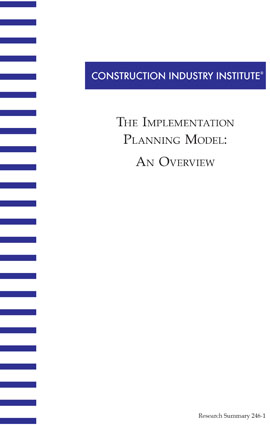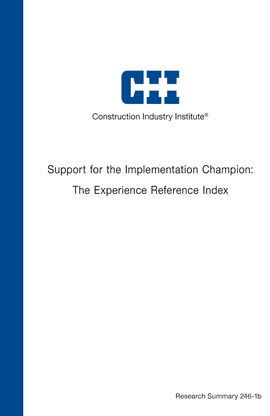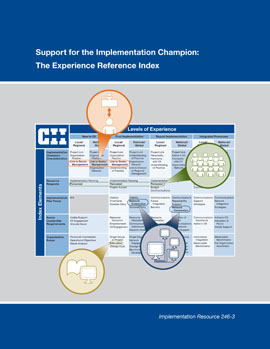
The Implementation Planning Model: An Overview
No organization can maintain “status quo” indefinitely and remain competitive in today’s changing business environment. The need for improvement and change varies and is heavily dependent on organization culture, market demands, competition, work force demographics, longheld industry practices, and a necessary focus on minimizing risk. Even with these forces working for and against change, an organization must decide to improve and modify procedures on a regular and continuing basis. Given this demand for continuous change and the introduction of new practices, the question arises as to why organizations have been traditionally reluctant to introduce and implement best practices.
To assist Construction Industry Institute (CII) members to implement change successfully, the Implementation Strategy Committee introduced the CII Implementation Pyramid approach as an overall model for the implementation process. This research builds on the Pyramid by recognizing that the greatest organizational challenge in initiating new practices is the development of an implementation plan. Specifically, organizations require an implementation plan that provides enough detail so all personnel impacted by the planned change understand the roadmap that is going to be followed. Organizations undertaking an implementation process often fail to establish this roadmap or vision for implementing a proposed practice. The CII Implementation Pyramid recognizes the need for a plan, but does not provide specific details that an organization should follow when developing a plan for a new practice. This work fills a gap which is essential to the successful implementation of the pyramid and is primarily focused on Level 4, “Implementation Plan and Goals.”
This publication describes the background leading to the development of the Implementation Planning Model and its individual components. This model includes a comprehensive process for approaching and implementing new practices. The Implementation Planning Model introduces the implementation steps intended to provide an organized approach to successful implementation. The Implementation Strategy Committee recommends the use of this Implementation Planning Model (Implementation Resource IR 246-2) to develop a comprehensive plan that fully addresses the challenges and achieves the opportunities afforded by implementing a proposed new practice. The implementation resource will give greater detail and provide a guide for any organization to utilize the Implementation Planning Model to develop plans and assess their progress on the roadmap to success.
This implementation resource is derived from Research Report 246-11, “The Implementation Planning Model: Steps to Success.” For a full treatment of this topic, including research performed and basis for the approaches recommended herein, RR 246-11 should be consulted.
Stage 1: Needs Analysis – The Needs Analysis lays out the case for implementing a new practice. This case will need to be presented to both management and critical staff, so a compelling argument is required as an output of this stage.
Stage 2: Management Buy-In – The management buy-in will be based on the Needs Analysis developed in Stage 1.
Stage 3: Establish Steps – The Implementation Planning Model establishes a series of four critical steps that will be followed during the implementation process. The third stage in the overall process requires one to understand these steps and develop an approximate schedule for the implementation process.
Stage 4: Adapt Matrix – In this stage, the implementation team must take the specifics within the Implementation Matrix and adapt the generic elements with organization specifics that address the unique requirements of the current implementation task.
Stage 5: Develop Plan – In this stage, the team will translate the details from Stage 4 into a plan that meets the requirements of the specific organization.
Stage 6: Communicate Plan – This stage requires the team to communicate the proposed implementation plan to both management and the proposed test group.
Stage 7: Perform Change Audit – The implementation team will perform a Change Audit that evaluates the readiness of the organization to undertake the implementation process.
Stage 8: Implement Tasks/Plan – The implementation team will now follow the tasks laid out in the implementation plan for each step of the implementation process. Each step in the process has a set of three to five tasks that are critical for success in that step.
Stage 9: Perform Step Evaluations – In conjunction with Stage 8, the implementation team will perform evaluations during each step of the implementation process to determine if the process is achieving required goals.
Stage 10: Benchmark – The final stage in the implementation process is to benchmark the new practice both internally and externally.
- Processes include any formal and informal procedures that direct how operations are completed within any segment of the organization.
- Structure of the organization refers to the formal lines of authority and informal lines of communication and authority.
- Culture includes the norms, practices, and shared beliefs and attitudes of the individual people within the organization.
- Business focuses on the underlying business model incorporated by the organization. Introducing a practice will impact the model by addressing issues such as competitiveness, strategies, and strategic management.



